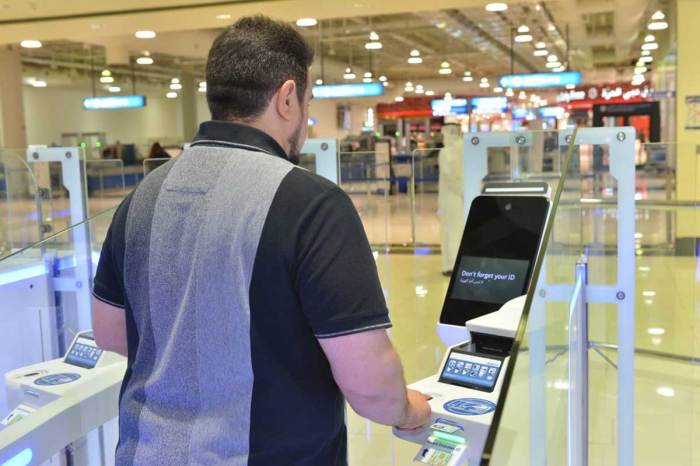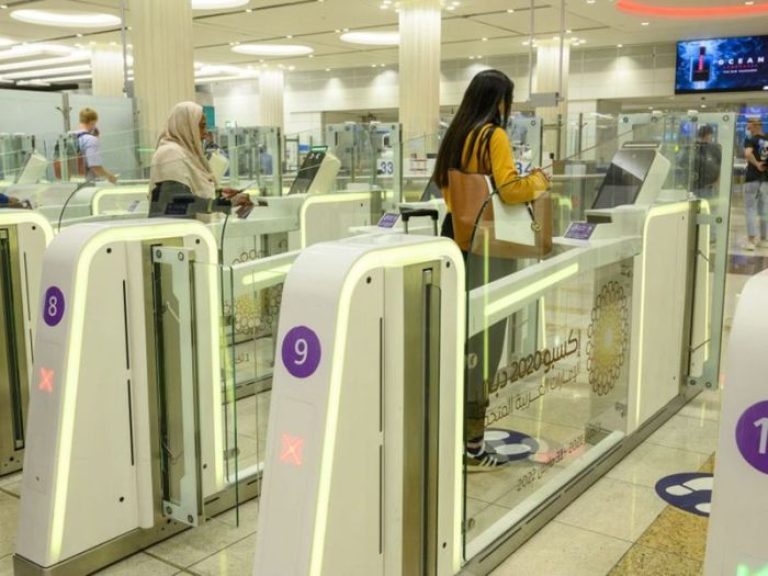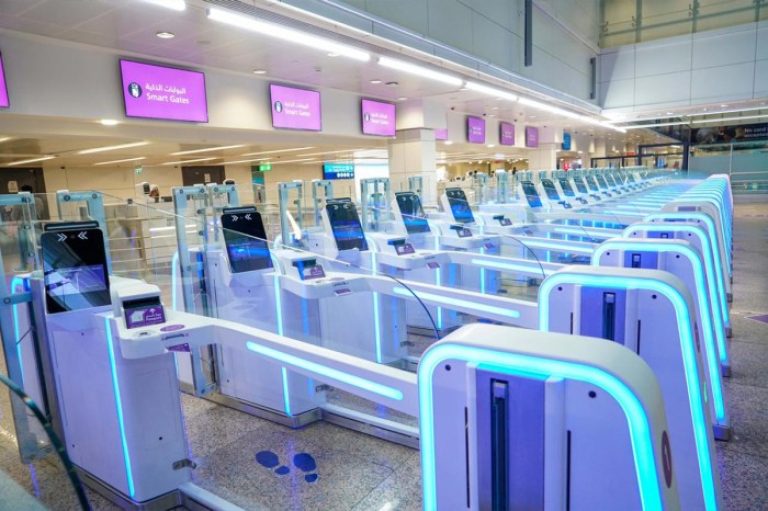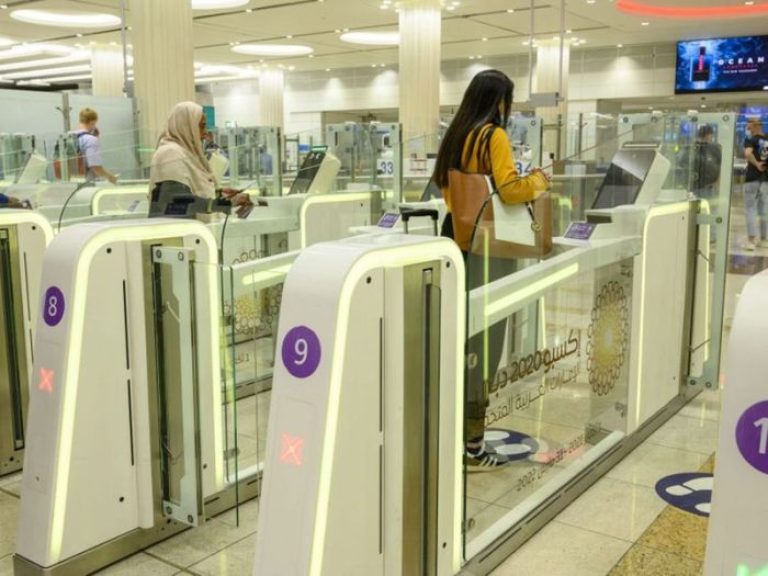Expo 2020 travellers smart gates dubai airporte – Expo 2020 travelers experienced Dubai Airport’s smart gates firsthand, a technology designed to streamline passenger processing. These automated gates, utilizing biometric data and advanced technology, significantly impacted the overall visitor experience during the massive event. This article explores how these gates functioned, their impact on Expo 2020 attendees, and their broader implications for future travel.
We’ll delve into the specifics of using the smart gates, address security and privacy concerns, and compare Dubai’s system to those used in other major international airports. We’ll also look at potential future improvements and applications of this technology beyond airport settings. Get ready for a quick and informative look at how technology shaped the Expo 2020 experience.
Expo 2020 Dubai and Traveler Experience
Expo 2020 Dubai aimed for a seamless visitor experience, prioritizing ease of access and navigation within its vast site. The event leveraged advanced technology and comprehensive planning to manage the expected influx of millions of international visitors. This involved a multifaceted approach encompassing transport, infrastructure, and on-site support systems.Expo 2020’s infrastructure supported a remarkably high volume of visitors.
A dedicated metro line directly connected the site to the city, significantly reducing travel time and congestion. Extensive internal transportation options, including electric buses and autonomous vehicles, facilitated movement within the expansive Expo grounds. The site itself was meticulously designed with clear signage, numerous information points, and easily accessible amenities like restrooms and resting areas. This strategic infrastructure minimized visitor frustration and enhanced overall enjoyment.
Ease of Access and Navigation at Expo 2020
The Expo 2020 site was designed with intuitive navigation in mind. A user-friendly mobile application provided real-time information on events, pavilion locations, transportation schedules, and wait times. Clear wayfinding signage, both physical and digital, guided visitors throughout the site, reducing confusion and ensuring they could easily locate their desired destinations. The application also allowed visitors to plan their routes in advance, optimizing their time at the Expo.
This combination of digital and physical guidance proved highly effective in managing the large crowds.
Infrastructure Supporting High Visitor Volume
The infrastructure supporting Expo 2020’s high visitor volume was a key element of its success. The dedicated metro line, mentioned previously, was crucial in transporting visitors efficiently to and from the Expo site. Furthermore, ample parking facilities were available for those arriving by car, complemented by well-organized traffic management systems. Within the Expo site, a network of pathways, electric buses, and autonomous vehicles ensured smooth movement, even during peak hours.
The site’s design also incorporated numerous rest areas and shaded zones, providing respite from the heat for visitors. This comprehensive infrastructure effectively handled the significant daily attendance figures.
Comparison to Other Large-Scale International Events
Compared to other large-scale international events like the Olympic Games or FIFA World Cups, Expo 2020 Dubai demonstrated a high level of visitor management efficiency. While those events often face challenges related to transportation and overcrowding, Expo 2020’s integrated transport system and well-planned site layout mitigated many of these issues. The use of a dedicated mobile application, providing real-time information and personalized itineraries, also set it apart.
The overall visitor experience was generally considered positive, with high levels of satisfaction reported in post-event surveys. This suggests a higher level of proactive planning and technological integration compared to similar events.
Dubai Airport Smart Gates Functionality

Dubai Airport’s smart gates offer a streamlined and efficient way to pass through passport control, leveraging advanced technology to minimize wait times and enhance the overall passenger experience. These automated gates use biometric technology to verify passenger identities, significantly speeding up the immigration process compared to traditional methods.The technology behind Dubai Airport’s smart gates relies primarily on facial recognition and passport scanning.
Passengers present their passport at a designated scanner, and their faces are then captured by a high-resolution camera. The system compares the biometric data (facial features) with the information stored in the passenger’s passport and immigration databases. If a match is confirmed, the gate automatically opens, allowing the passenger to proceed. This process is designed to be quick, secure, and user-friendly.
Smart Gate Usage: A Step-by-Step Guide
To use the smart gates, passengers must first meet certain eligibility criteria. These typically include holding a valid passport from a participating country and being enrolled in the relevant smart gate program (often requiring prior registration online or at a dedicated kiosk).
- Eligibility Check: Before approaching the gate, ensure you meet the eligibility requirements. If uncertain, check the information screens near the smart gates or inquire with airport staff.
- Passport Presentation: Place your passport on the designated scanner, ensuring it is flat and clearly visible. The system will automatically read your passport details.
- Facial Recognition: Stand in front of the camera and maintain a natural expression, ensuring your face is fully visible and well-lit. The system will capture your facial image.
- Biometric Verification: The system will process your data, comparing your facial features with the information in your passport. This process usually takes only a few seconds.
- Gate Access: If the verification is successful, the gate will open, allowing you to proceed. If not, you will be directed to a traditional passport control counter for manual processing.
Smart Gates vs. Traditional Passport Control
Smart gates offer several advantages over traditional passport control procedures. The most significant benefit is reduced waiting times. The automated process significantly speeds up the immigration process, especially during peak hours when traditional queues can be lengthy. Additionally, smart gates provide a more contactless experience, minimizing physical interaction with immigration officers and potentially reducing the risk of disease transmission.
However, not all passengers are eligible to use smart gates. Those ineligible, such as passengers with damaged passports or those requiring additional immigration checks, must use the traditional passport control counters. This can sometimes lead to longer lines at these counters. The technology itself also presents potential issues, such as malfunctioning equipment or difficulties with facial recognition due to poor lighting or unusual facial features.
Integration of Smart Gates with Expo 2020 Travel
The Dubai Airport’s smart gates played a crucial role in ensuring a smooth and efficient travel experience for the millions of visitors attending Expo 2020. Their seamless integration into the overall travel infrastructure significantly minimized potential bottlenecks and enhanced the overall visitor satisfaction. This system allowed for faster processing of passengers, reducing wait times and contributing to a more positive perception of the event.The smart gates significantly reduced wait times for Expo 2020 attendees.
By automating the passport control process, these self-service kiosks eliminated the need for lengthy queues at traditional immigration counters. This resulted in faster processing times, allowing visitors to proceed quickly through the airport and reach their destinations with minimal delays. The improved efficiency not only saved time for individual travelers but also contributed to a more streamlined flow of passengers through the airport, reducing overall congestion.
This positive impact on passenger experience is particularly significant during large-scale events like Expo 2020, where high passenger volumes are expected.
Impact of Smart Gates on Expo 2020 Passenger Flow
Without the smart gates, the influx of visitors during Expo 2020 would have undoubtedly led to significantly longer wait times at passport control. Imagine the scene: thousands of travelers, many unfamiliar with the airport layout, all converging on a limited number of manual immigration counters. The resulting queues could have extended for hours, causing significant frustration and delays.
This would have created a negative first impression for many visitors, potentially impacting their overall experience of Expo 2020 and Dubai. The sheer volume of people, coupled with language barriers and the general complexities of international travel, would have magnified the problem exponentially. Consider, for example, a major sporting event like the Olympics or a large-scale music festival – the long queues and frustrating wait times are a common complaint.
Expo 2020, with its global reach and anticipated attendance, would have faced an even greater challenge without the efficient processing power of the smart gates.
Hypothetical Scenario: Expo 2020 Without Smart Gates, Expo 2020 travellers smart gates dubai airporte
Let’s imagine a hypothetical scenario where the Dubai Airport did not implement smart gates for Expo 2020. A conservative estimate of daily Expo visitors might be around 250,000 during peak times. With only traditional manual passport control, assuming an average processing time of 5 minutes per passenger, it would take approximately 2,083 hours (or about 87 days) to process just one day’s worth of visitors.
This is clearly impractical. The resulting congestion would have created massive bottlenecks not only at immigration but also throughout the airport, potentially leading to missed flights, delayed onward travel, and widespread dissatisfaction amongst attendees. Furthermore, the logistical challenges of managing such immense queues would have been substantial, requiring a significant increase in airport staff and resources. The negative publicity surrounding such delays could have seriously damaged Dubai’s reputation as a global travel hub.
Future Improvements and Innovations: Expo 2020 Travellers Smart Gates Dubai Airporte

Dubai Airport’s smart gates, while impressively efficient, offer significant room for improvement and innovation. Integrating cutting-edge technologies can further enhance passenger experience, security, and operational efficiency. This section explores potential advancements and applications that could revolutionize the smart gate system and its broader use.The current smart gate system relies primarily on passport scanning for verification. Future improvements should focus on enhancing this core functionality and expanding the system’s capabilities through the integration of additional biometric technologies and data sources.
Biometric Technology Expansion
Expanding beyond passport scanning, incorporating additional biometric identifiers like facial recognition, iris scanning, and fingerprint verification could significantly bolster security and streamline the passenger flow. Facial recognition, already utilized in some capacity, could be enhanced with advanced algorithms for greater accuracy and speed, even in challenging lighting conditions or with variations in passenger appearance. Iris scanning offers a high degree of accuracy and is less susceptible to spoofing attempts compared to fingerprint scanning.
A multi-modal biometric approach, combining several technologies, would provide a robust and highly secure verification system, reducing the risk of identity theft or unauthorized access. This layered security approach is already being implemented in high-security settings and could be adapted for airport smart gates. For example, the combination of facial recognition and iris scanning could significantly reduce false acceptance and rejection rates compared to using either technology alone.
Enhanced Data Integration and Predictive Analytics
Integrating smart gate data with other airport systems, such as flight information displays, baggage handling systems, and passenger information databases, could offer significant operational advantages. This integration would allow for real-time monitoring of passenger flow, identification of potential bottlenecks, and proactive adjustments to optimize throughput. Further, predictive analytics could be applied to this integrated data to forecast passenger volumes, predict potential delays, and proactively allocate resources to prevent congestion.
This is similar to how online retailers use data to anticipate demand and optimize inventory management. Airlines could leverage this information for better flight scheduling and resource allocation, while airport authorities could improve passenger experience by anticipating and addressing potential delays before they impact travellers.
Smart Gate Applications Beyond Airports
The technology behind Dubai Airport’s smart gates has broader applications beyond airport security. The system’s core components – biometric identification, automated access control, and data analytics – could be easily adapted for use in other high-traffic environments. For instance, similar smart gate systems could be implemented in large stadiums, concert venues, and other entertainment facilities to expedite entry and exit processes, improving crowd management and security.
Transportation hubs like train stations and bus terminals could also benefit from these systems, streamlining passenger boarding and reducing waiting times. Imagine a seamless journey where your biometric credentials grant access to public transportation, airport security, and even your hotel room, all without needing to present physical identification multiple times. This integrated system could be implemented in major cities, creating a streamlined and secure travel experience across various transportation modes.
Illustrative Example: A Traveler’s Journey
This section details a typical traveler’s experience using Dubai Airport’s smart gates, specifically focusing on their journey from arrival to their Expo 2020 destination. We’ll walk through the process, highlighting both the smooth aspects and any potential challenges encountered.
Imagine Sarah, a visitor from London, arriving at Dubai International Airport after a long flight. She’s excited to experience Expo 2020 and is eager to get to her hotel quickly and efficiently.
Arrival and Immigration
Upon disembarking, Sarah follows the signs to immigration. She notices the designated smart gate lanes, clearly marked and less crowded than the traditional counters. Having already enrolled in the UAE’s smart gate program online prior to her trip, she simply scans her passport at the designated reader. The system verifies her identity and a gate opens, allowing her to proceed through immigration swiftly and seamlessly.
Baggage Claim and Transportation
After clearing immigration, Sarah heads to baggage claim. The digital displays clearly indicate her flight’s baggage carousel. She retrieves her luggage without delay. Next, she opts for the Dubai Metro, a convenient and efficient way to reach her Expo 2020 hotel. Clear signage guides her to the metro station, which is easily accessible from the airport.
Expo 2020 Access
Sarah arrives at the Expo 2020 station and easily finds her way to the designated Expo entrance. While not directly integrated with the smart gates at the airport, her pre-booked Expo ticket and efficient public transportation allow for a smooth transition between the airport and the Expo site. The entire journey is seamless and efficient, allowing her to maximize her time at the Expo.
Addressing Potential Challenges
Let’s consider a hypothetical scenario where Sarah had encountered a problem. Suppose her passport scan failed at the smart gate. The system would have likely displayed a clear error message, prompting her to seek assistance at a nearby immigration counter. An immigration officer would have assisted her, resolving the issue quickly and guiding her through the necessary steps, likely involving a manual passport check.
While this would add a few minutes to her journey, the overall process would still be far more efficient than waiting in a long traditional queue.
Comparative Analysis of Different Smart Gate Systems
Dubai Airport’s smart gate system is a leading example of automated border control, but how does it stack up against similar systems in other major international airports worldwide? This comparison focuses on efficiency metrics and passenger experience, highlighting both strengths and weaknesses across different implementations. We’ll explore how technology choices and design considerations impact the overall user journey.
Several factors contribute to the success or failure of a smart gate system. These include the technology used for biometric identification (fingerprint, facial recognition, iris scanning), the integration with other airport systems (check-in, baggage handling), and the overall user interface design. A seamless and intuitive experience is crucial for minimizing wait times and improving passenger satisfaction.
Smart Gate System Comparison: Dubai vs. Other Major Airports
The following table compares the smart gate systems used in Dubai International Airport (DXB) with those found in other major international airports. Data is based on publicly available information and reports from various airport authorities and travel organizations. Note that specific details about proprietary technologies are often limited.
| Airport | Biometric Technology | Integration with Airport Systems | Passenger Experience Feedback (Qualitative) |
|---|---|---|---|
| Dubai International Airport (DXB) | Primarily facial recognition, supplemented by other biometric options. | Highly integrated with check-in, baggage handling, and other airport services. Offers seamless transfer between systems. | Generally positive, with reports highlighting speed and ease of use. However, occasional technical glitches and challenges for passengers with specific needs are mentioned. |
| Heathrow Airport (LHR), London | Primarily ePassport gates utilizing chip-based passport data. Facial recognition is increasingly being incorporated. | Good integration with other airport systems, although improvements are ongoing. | Mixed reviews. While many praise the speed, some users report longer wait times during peak periods or experience difficulties with malfunctioning gates. |
| Amsterdam Schiphol Airport (AMS) | Uses a combination of biometric technologies, including facial recognition and ePassport gates. | Strong integration with other systems, facilitating a smooth passenger flow. | Generally positive, with emphasis on efficiency and ease of use. Continuous improvements are noted based on passenger feedback. |
| John F. Kennedy International Airport (JFK), New York | A mix of ePassport gates and increasing implementation of biometric technologies, but adoption is slower compared to some other major airports. | Integration varies depending on the terminal and airline. Improvements are underway to standardize the system. | Reviews are varied, with some highlighting improvements in recent years, while others still cite long wait times and inconsistent performance. |
Dubai Airport’s smart gates proved invaluable during Expo 2020, significantly reducing wait times and enhancing the overall travel experience for millions of visitors. The successful implementation highlights the potential of advanced technology to manage large-scale events efficiently and securely. While security and privacy considerations remain crucial, ongoing improvements and wider adoption of similar systems promise smoother, faster travel in the future.
The Expo 2020 experience serves as a compelling case study for the benefits of integrating smart technologies into global travel infrastructure.
FAQ Resource
What happens if the smart gate malfunctions?
Airport staff are readily available to assist passengers experiencing issues with the smart gates. There are alternative manual passport control processes in place.
Are there age restrictions for using the smart gates?
Generally, unaccompanied minors or those needing special assistance may not be eligible. Check with airport staff for specific requirements.
What type of passport is needed to use the smart gates?
Eligibility varies; usually, machine-readable passports are required. Check Dubai Airports website for the most up-to-date information on accepted passport types.
What data is collected by the smart gates?
Typically, only passport information and biometric data (like facial recognition) are collected, and are subject to strict data privacy regulations.


